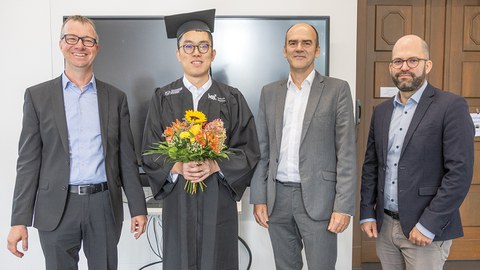22.10.2025
Promotion Jiafeng Zhou

Jiafeng Zhou und die anwesende Promotionskommission
Am 17.10.2025 verteidigte Herr Jiafeng Zhou, M.Eng., erfolgreich seine wissenschaftliche Arbeit im Rahmen des Promotionsverfahrens 👨🎓 mit dem Thema „Investigations on the bond behaviour of a hybrid lap-spliced connection of GFRP and stainless steel bars“. Neben dem Vorsitzenden der Promotionskommission, Prof. Dr. Jens Otto, (TU Dresden), war als Gutachter Prof. Dr. Steffen Marx (TU Dresden) anwesend. Als weiteres Mitglied der Promotionskommission war Prof. Dr. Robert Jockwer (TU Dresden) anwesend.
Abstract:
Mit dem anhaltenden weltweiten Bevölkerungswachstum steigt auch der Energiebedarf, was zu einem erheblichen Anstieg des Ressourcenverbrauchs führt – insbesondere im Bereich Strom und Heizöl. Infolgedessen ist eine Steigerung der Energieeffizienz zu einer dringenden Notwendigkeit geworden, nicht nur zum Schutz der Umwelt, sondern auch zur Reduzierung finanzieller Belastungen. Bei traditionellen Balkonanschlüssen werden in den Isolationsfugen gewöhnliche Stahlbewehrungen mit hoher Wärmeleitfähigkeit als Zugstäbe eingesetzt, um Innen- und Außenbereiche miteinander zu verbinden. Dies führt zu erheblichen Energieverlusten aufgrund ausgeprägter Wärmebrücken. Im Vergleich dazu weist das Material glasfaserverstärkter Kunststoff (GFRP) eine deutlich geringere Wärmeleitfähigkeit auf – nur etwa 1 % derjenigen von Stahl. Daher ist GFRP ein idealer Ersatz für Stahlstäbe in solchen Anschlussbereichen. In dieser Dissertation wird daher eine neuartige hybride Übergreifungs-Verbindung (Lap-Splice) zwischen GFRP-Stäben und Stahlstäben in benachbarten Bauteilen vorgestellt, die bisher kaum erforscht ist.
In der ersten Publikation dieser kumulativen Dissertation wird umfassendes Wissen über die Übergreifung von GFRP- und Stahlstäben in biegebeanspruchten Betonbauteilen zusammengetragen und systematisch ausgewertet. Aufbauend auf diesen Ergebnissen wird eine Untersuchungsmethodik in drei Stufen entwickelt, um das mechanische Verhalten der hybriden Übergreifungsverbindung zwischen GFRP- und Stahlstäben zu analysieren. In der zweiten Publikation werden die ersten beiden Stufen dieser Methodik vorgestellt. Zunächst werden Zugversuche mit zwei Typen von GFRP-Stäben und einem Typ Edelstahlstab durchgeführt, um deren mechanische Eigenschaften zu ermitteln. In nachfolgenden Verbundversuchen wird das Verbundverhalten zwischen Beton und jeweils einem Einzelstab untersucht. Dabei kommen vier Kombinationen aus verteilten faseroptischen Sensoren (DFOS) und Klebstoffen in den Längsnuten eines GFRP-Stabtyps zum Einsatz, um deren Einfluss auf die gemessenen Stabdehnungen zu analysieren. Die ermittelte optimale Kombination wird anschließend auch bei den anderen zwei Stabtypen eingesetzt, um deren unterschiedliches Verbundverhalten im Beton zu untersuchen.
Die dritte Publikation konzentriert sich hauptsächlich auf die dritte Stufe, nämlich auf tatsächliche Übergreifungsverbindungen. Im ersten Schritt wird die Mikrostruktur der GFRP-Stäbe analysiert, um deren spezifische Materialeigenschaften zu verstehen. Im zweiten Schritt wird durch Kragarmversuche die optimale Ausrichtung der DFOS-Nuten bestimmt. Im dritten Schritt werden der Einfluss der Übergreifungslänge sowie des Übergreifungstyps auf das Verbundverhalten in hybriden Übergreifungsverbindungen mittels Vier-Punkt-Biegeversuchen untersucht. Besonders die Dehnungsverteilungen im Bereich der Übergreifung werden detailliert analysiert. Darüber hinaus werden die Dehnungen und Spannungen an den Übergreifungsenden bei unterschiedlichen Belastungen erfasst. Abschließend werden die maximalen experimentellen Lasten mit den Ergebnissen der Berechnung nach dem Grenzzustandsverfahren verglichen.
Am Ende der Dissertation werden mehrere weiterführende Untersuchungen durchgeführt. Zunächst erfolgt ein Vergleich der Stabdehnungsverteilungen zwischen den Verbundversuchen und den Vier-Punkt-Biegeversuchen. Zusätzlich werden die Rissbilder im Übergreifungsbereich der Biegeversuche analysiert. Anschließend werden numerische Simulationen durchgeführt, um die experimentellen Ergebnisse aus den Verbund- und Biegeversuchen zu validieren. Darauf aufbauend werden Parameterstudien mit den validierten Finite-Elemente-Modellen (FEM) durchgeführt, um die kritische Verankerungslänge der GFRP-Stäbe sowie die optimale Übergreifungslänge zwischen GFRP- und Edelstahlstäben zu bestimmen. Die Ergebnisse werden abschließend mit Berechnungen nach verschiedenen nationalen und internationalen Normen verglichen.
Auf Grundlage der oben genannten Untersuchungen kann geschlossen werden, dass der Ersatz von Stahlstäben durch GFRP-Stäbe nicht nur das thermische Verhalten der Übergreifungsverbindung verbessert, sondern auch die mechanische Leistungsfähigkeit, wie beispielsweise die Tragfähigkeit von Stahlbetonbauteilen, steigert. Darüber hinaus zeigt sich, dass die in den aktuellen Normen enthaltenen Regelwerke zur Bestimmung von Verankerungs- und Übergreifungslängen weiterer Überarbeitung bedürfen. Hierzu sind zusätzliche experimentelle und numerische Untersuchungen erforderlich, um genauere und verlässlichere Ergebnisse zu erzielen.
Lieber Jiafeng Zhou, wir wünschen viel Erfolg für die weitere wissenschaftliche Karriere und natürlich alles Gute für die Zukunft! 👍🥳
